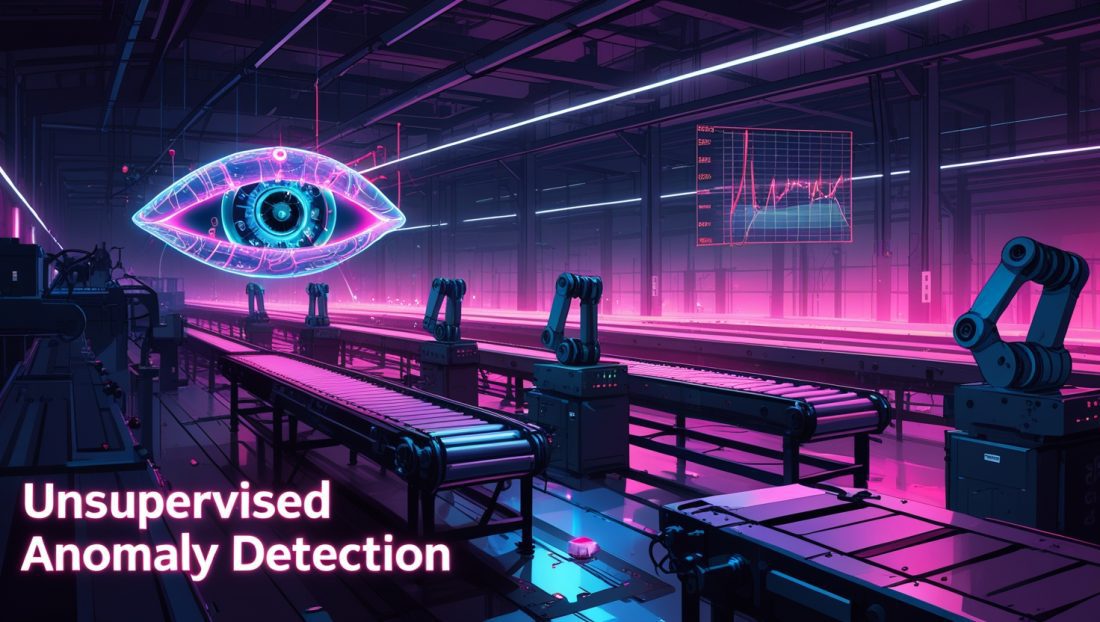The Hidden Threat in Your FactoryWhat if your production line could alert you to a hidden malfunction before it triggers a catastrophic shutdown? In March 2025, a German automotive plant faced this reality. A robotic arm’s bearing emitted faint vibrational anomalies—invisible to human operators and traditional monitoring systems. Within weeks, the component failed, halting production for 32 hours and costing €1.2 million. This incident exposes a universal vulnerability: conventional threshold-based monitoring misses early-stage failures.
Unsupervised anomaly detection represents a paradigm shift. Unlike supervised machine learning requiring labeled failure data, it identifies deviations in real-time sensor streams without predefined patterns. Manufacturing leaders who implement this technology gain an anticipatory advantage—transforming factories from reactive cost centers to proactive profit engines. For deeper insights into how AI-driven solutions are reshaping factory efficiency, explore why predictive maintenance AI leads factory efficiency in 2025.
1. The Industrial Imperative: Why Unsupervised Learning Dominates Failure Prevention
The Data Deluge Crisis
Modern production lines generate 19 terabytes of sensor data daily—vibration signatures, thermal imaging, acoustic emissions, and power fluctuations. Manual analysis is impossible, while supervised ML fails because:
- Label Scarcity: Equipment operates normally 97% of the time, creating minimal failure examples for training.
- Evolving Failure Modes: New defects emerge constantly, lacking historical signatures.
Real-World Impact: Siemens’ Amberg Electronics Plant reduced false alarms by 83% after replacing supervised models with unsupervised anomaly detection that established dynamic baselines across 1,200+ sensors.
Why Unsupervised Detection Closes the Gap
These algorithms model “normal” operational behavior, flagging deviations as potential failures:
- ECOD Algorithms: Compare real-time feature distributions against training data to identify statistical outliers.
- K-Nearest Neighbors: Isolate anomalies as data points distanced from dense operational clusters.
Dr. Lena Schmidt of the Fraunhofer Institute notes that threshold alarms miss subtle issues, while unsupervised ML catches bearing wear months early.
2. Cutting-Edge Architectures: Beyond Basic Algorithms
Behavioral Analysis for Cyber-Physical Threats
Industrial control systems face escalating sabotage risks. Unsupervised anomaly detection counters this by:
- Mapping legitimate device communication patterns to flag unauthorized data flows
- Sharing anomaly signatures across similar assets (e.g., one turbine’s detection updates global models)
Proven Case: After a 2024 ransomware attack disabled a Belgian chemical plant, Darktrace’s unsupervised system prevented recurrence by identifying anomalous data packets in PLC controllers within 0.8 seconds. This capability aligns with advancements in AI-driven cybersecurity threat detection, which is critical for securing smart factories in 2025.
This proactive approach leverages industrial cybersecurity AI solutions to detect subtle network anomalies, such as unauthorized access attempts or irregular data spikes. By analyzing behavioral patterns in real time, these systems ensure rapid response to cyber threats, reducing downtime risks. For further reading, Darktrace’s case studies showcase how unsupervised learning thwarts sophisticated attacks in manufacturing environments.
Explainable AI for Actionable Diagnostics
Black-box models frustrate engineers. Modern frameworks solve this:
- DAXS Systems: Pinpoint exact sensors causing alerts (e.g., “Motor 7 Temperature Deviation: +4.2°C”)
- Visual Root-Cause Mapping: Overlay thermal anomalies on 3D equipment models for rapid diagnosis
Quantifiable Result: Vestas Wind Systems reduced diagnostic time by 70% using explainable AI, saving $1.4M in quarterly maintenance costs.
3. Real-World Applications: Quantifiable ROI Across Industries
Predictive Maintenance at Extreme Scales
Turkish Tile Producer Vitra Karo deployed vibration sensors in 1,500°C kilns. Unsupervised anomaly detection identified thermal stress patterns 8 days before failures, achieving:
- 50% reduction in unplanned downtime
- €380,000 annual savings on emergency repairs
Zero-Defect Quality Control
Computer vision paired with unsupervised learning achieves superhuman precision:
- Micron-Level Semiconductor Inspection: Detects wafer defects smaller than human hair (0.02mm)
- Pharmaceutical Blister Pack Verification: Identifies missing pills at 120 packs/minute with 99.999% accuracy
Edge Deployment Advantage
Tesla’s Berlin gigafactory runs anomaly detection locally on NVIDIA Jetson modules, eliminating cloud latency for real-time defect rejection. This edge-based approach complements edge AI vs. cloud AI industrial optimization strategies, enabling faster, more secure decision-making.
By prioritizing real-time edge AI for manufacturing, factories achieve millisecond-level responses to anomalies, critical for high-speed production lines. This reduces reliance on cloud connectivity, lowering latency and enhancing data privacy. NVIDIA’s Jetson platform documentation highlights its role in powering edge AI for industrial applications.
4. Implementation Roadmap: Avoiding Critical Pitfalls
Data Quality Foundations
Operational technology (OT) environments suffer from noisy data. Success requires:
- Hybrid Edge-Cloud Processing: Filter sensor noise locally before central analysis
- Sensor Fusion: Combine vibration, thermal, and acoustic streams for contextual insights
Fictional Anecdote: At “Factory Prime” in Michigan, engineers integrated ultrasonic mics with infrared cameras. This fusion detected compressor cavitation 47 hours before failure—saving $92,000 in replacement costs.
Scaling Across Global Operations
Training equipment-specific models demands:
- Distributed Computing: ABB Ability™ platform trains 15,000 motor models simultaneously
- Automated DataOps: Standardize feature extraction across multilingual facilities
Critical Lesson: Schneider Electric’s phased rollout across 78 plants cut implementation costs by 62% versus big-bang deployments.
5. The 2025 Horizon: Next-Generation Industrial AI
Generative AI for Synthetic Failure Data
Simulating rare events addresses data scarcity:
- Digital twins generate synthetic bearing failures for algorithm training
- MIT’s 2024 study showed synthetic data improved anomaly detection F1-scores by 31%
Autonomous Process Optimization
Reinforcement learning enables self-correcting systems:
- Chemical reactors automatically adjust pressure/temperature when drift occurs
- Predictive ROI: 12-18 month payback periods per Deloitte’s 2025 Smart Factory Survey
Market Surge: The industrial anomaly detection segment will reach $28B by 2030 (Allied Market Research)
Your Competitive Imperative
Unsupervised anomaly detection transforms manufacturing resilience:
- Preempt failures before cascade effects occur
- Optimize maintenance budgets with targeted interventions
- Outperform competitors through operational excellence
Henry Kirkman of Verdantix emphasizes that ECOD and Isolation Forest algorithms deliver ROI within 18 months. Delaying adoption is a strategic risk.
Act Now: Download Our Implementation Checklist (Coming Soon)
Disclaimer: This article contains hypothetical scenarios and estimated figures for informational purposes only. Some case studies and statistics are illustrative and not directly verified.
FAQ: Addressing Key Concerns
What’s the typical implementation cost?
Mid-size plants invest $120K-$500K, achieving ROI in 14-24 months via downtime reduction.
Can legacy equipment support this technology?
Yes. Retrofit kits (e.g., Siemens SenseEdge) add IIoT capabilities to 20-year-old machines.
How do we handle data security?
On-premise processing (like Rockwell Automation’s Edge Gateway) keeps sensitive data locally.
What skills do our team need?
Cross-train process engineers with no-code platforms like PTC ThingWorx. Certification takes <3 weeks.
How quickly do results appear?
Initial pilot deployments detect anomalies in 6-8 weeks. Full scaling requires 5-9 months.

